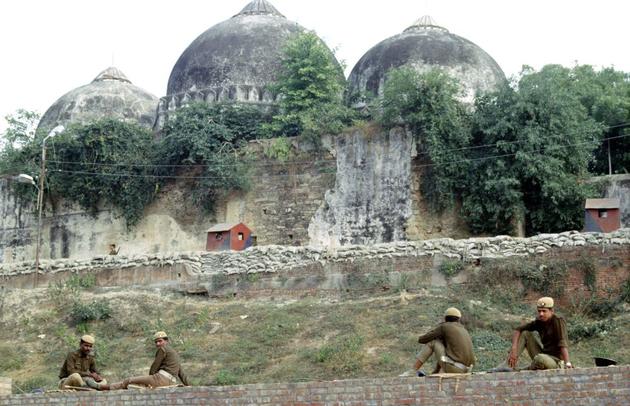
A scene during the demolition of the Babri Masjid on December 6, 1992. Photo: The Hindu Photo Archive
Bajrang Dal to observe Babri anniversary as ‘valour day’.
Bajrang Dal will observe the 23rd anniversary of the Babri mosque demolition on Sunday as “Shourya Divas” (Valour Day). While the organisation has been observing the day all these years, the context of the recent death of Ashok Singhal, leader of the VHP, its parent organisation, and the Sangh Parivar’s reiteration of its commitment to build a Ram temple as the “true” tribute to him, has made the event, otherwise “routine”, acquire greater symbolic importance.
Nationwide programmes
There will be programmes across the country, including at Karsevakpuram in Ayodhya, where the mosque stood till December 6, 1992.
Fireworks, processions, recitation of Hanuman Chalisa and a pledge in support of the temple are part of the celebration, VHP leader Vinod Bansal said.
Mr. Bansal said “Shourya Divas” had helped the organisation “pay tribute” to those who contributed to the Ram temple movement and inform the youth about it to have a future supply of sympathisers for the cause.
VHP wants law to build Ram temple
The VHP has reiterated that the Centre should get a law passed by Parliament or promulgate an ordinance to pave the way for a Ram temple at Ayodhya.
“Four rounds of talks have failed as the rival party ran away from them. Now the one way out is to build a Ram temple the way the Somnath temple was rebuilt after Independence. The government should pass a Bill in Parliament or bring an ordinance for the same,” VHP joint general secretary Surendra Jain told The Hindu. “This would be a true homage to the late Ashok Singhal,” he said.
Left to protest today
The Left parties, which are observing a week-long protest against intolerance, will stage a protest across India on Sunday.
“The RSS has become desperate and wants to create strife and keep the temple issue alive. They are acting as an extra-constitutional authority. They know that the BJP government is fast getting unpopular and want to push through their divisive Hindutva agenda quickly,” CPI leader D. Raja told The Hindu. “We will remember this day both as Babri mosque demolition day and the death anniversary of Dr. Ambedkar, who gave us our progressive Constitution whose values we have to uphold.”
RSS chief Mohan Bhagwat recently said he was confident a Ram temple would come up in Ayodhya during his lifetime.
This had led to protests in Parliament by the Samajwadi Party, which accused the Sangh of disturbing social harmony.
The Ayodhya title suit has been pending before the Supreme Court after the parties challenged the Allahabad High Court’s decision to divide the site among the litigants.
THE CASE TIMELINE
- ›1949: Idols of Ram Lalla are placed surreptitiously under the central dome.
- › 1950: Gopal Simla Visharad files first suit in Faizabad civil court for rights to perform pooja to Ram Lalla.
- › 1950: Paramahansa Ramachandra Das files a suit for continuation of pooja and keeping idols in the structure.
- › 1959: Nirmohi Akhara files third suit, seeking direction to hand over charge of the disputed site. U.P. Sunni Central Wakf Board files fourth suit in 1961 for declaration and possession and fifth in 1989 in the name of Ram Lalla Virajman for declaration and possession.
- › 1986: District judge orderes locks be removed. Site opened for Hindu worshippers.
- › 1989: The four suits pending were transferred to the High Court.
- › 1991: U.P. govt. acquires land around the structure for convenience of devotees who attend Ram Lalla darshan.
- › 1993: Govt. takes over 67 acres of land around the area, seeks SC’s opinion on whether there existed a Hindu place of worship before the structure was built.
- › 1994: Case goes back to Lucknow Bench of HC, suits heard again from 1996.
From The Hindu Centre for Politics and Public Policy

What December 6 Means for India
In this essay, Mujibur Rehman analyses the reasons behind the shrinking of secular space and its implications for India’s politics and public discourse, the restructuring of the relationship between Indian Muslims and Hindutva ideology. Read more

Unambiguous Commitment to Secularism Needed
Prof. B.K. Chandrashekar, who had served as Karnataka’s Minister for Education, Chairman of the Karnataka Legislative Council, and as professor at the Indian Institute of Management, Bangalore, places the 1992 demolition in political perspective. Read More







